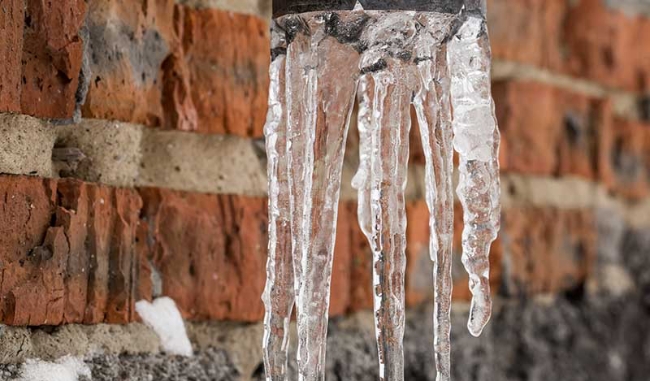Avoid Frozen Plumbing in Cold Weather: Professional Advice
Avoid Frozen Plumbing in Cold Weather: Professional Advice
Blog Article
Here underneath you can get a bunch of high-quality details with regards to How To Avoid Freezing Pipes.

Winter can ruin your plumbing, especially by freezing pipelines. Here's exactly how to stop it from happening and what to do if it does.
Introduction
As temperature levels drop, the risk of frozen pipes boosts, possibly leading to costly repair services and water damages. Understanding how to prevent icy pipes is important for home owners in cold climates.
Avoidance Tips
Shielding susceptible pipes
Cover pipes in insulation sleeves or use warmth tape to safeguard them from freezing temperature levels. Concentrate on pipes in unheated or external areas of the home.
Heating methods
Keep interior rooms adequately heated up, particularly areas with plumbing. Open up cupboard doors to allow warm air to flow around pipes under sinks.
Exactly how to identify icy pipelines
Look for decreased water flow from taps, uncommon smells or sounds from pipelines, and noticeable frost on subjected pipelines.
Long-Term Solutions
Architectural adjustments
Take into consideration rerouting pipes away from outside wall surfaces or unheated areas. Include added insulation to attics, basements, and crawl spaces.
Updating insulation
Invest in high-grade insulation for pipelines, attic rooms, and walls. Proper insulation helps maintain consistent temperatures and reduces the threat of icy pipelines.
Protecting Exterior Pipes
Garden hoses and exterior faucets
Detach and drain yard hose pipes before winter months. Mount frost-proof faucets or cover outdoor taps with insulated caps.
Understanding Icy Pipes
What creates pipelines to freeze?
Pipelines freeze when revealed to temperatures below 32 ° F (0 ° C) for expanded periods. As water inside the pipelines freezes, it increases, putting pressure on the pipe wall surfaces and possibly causing them to rupture.
Threats and damages
Icy pipelines can cause supply of water disturbances, building damage, and expensive repair work. Burst pipes can flood homes and trigger comprehensive architectural damage.
Indications of Frozen Piping
Recognizing frozen pipes early can prevent them from bursting.
What to Do If Your Pipelines Freeze
Immediate activities to take
If you presume frozen pipes, maintain taps available to ease pressure as the ice thaws. Utilize a hairdryer or towels soaked in warm water to thaw pipelines gradually.
Verdict
Protecting against icy pipelines requires aggressive steps and fast reactions. By recognizing the causes, indicators, and preventive measures, homeowners can safeguard their pipes throughout cold weather.
6 Proven Ways to Prevent Frozen Pipes and Protect Your Home
Disconnect and Drain Garden Hoses
Before winter arrives, start by disconnecting your garden hoses and draining any remaining water. Close the shut-off valves that supply outdoor hose bibs and leave the outdoor faucet open to allow any residual water to drain. For extra protection, consider using faucet covers throughout the colder months. It’s also important to drain water from any sprinkler supply lines following the manufacturer’s directions.
Insulate Exposed Pipes
Insulating your pipes is an effective way to prevent freezing. Pipe insulation is readily available at home improvement stores and is relatively inexpensive. Pay close attention to pipes in unheated areas such as the attic, basement, crawl spaces, or garage. Apply foam insulation generously to create a buffer against the cold. You can also wrap your pipes in heat tape or thermostat-controlled heat cables for added warmth.
Seal Air Leaks
Inspect your home for any cracks or openings that could let in cold air. Seal any holes around the piping in interior or exterior walls, as well as the sill plates where your home rests on its foundation. Additionally, make sure to keep your garage door closed unless you’re entering or exiting. Leaving it open creates a significant air leak that can lead to frozen pipes.
Allow Warm Air Circulation
During cold snaps, it’s essential to allow warm air to circulate evenly throughout your home. Leave interior doors ajar to promote better airflow. Open kitchen and bathroom cabinets to help distribute heat consistently around the rooms. If you have small children or pets, be sure to remove any household chemicals or potentially harmful cleaners from open cabinets for safety.
Let Faucets Drip
A small trickle of water can make a big difference in preventing ice formation inside your pipes. When temperatures drop significantly, start a drip of water from all faucets served by exposed pipes. This continuous flow helps prevent the water from freezing. Additionally, running a few faucets slightly can relieve pressure inside the pipes, reducing the chances of a rupture if the water inside does freeze.
https://choateshvac.com/6-proven-ways-to-prevent-frozen-pipes-and-protect-your-home/

I am very fascinated by Prevent Frozen Pipes and I hope you appreciated the entire post. Liked our piece of writing? Please quickly share it. Let somebody else locate it. Thank-you for going through it.
Article Report this page